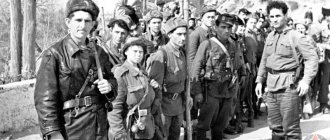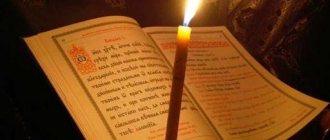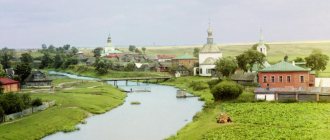Post a biography, about the company, services[en]
Home / Biographies / Namesakes / WWII 1941-1945 / Names / Patronymics / First name and patronymic / Horoscopes / Tests / Events
The Great Patriotic War of 1941-1945 (this article in English is the Great Patriotic War) - the liberation war of the Soviet people against Nazi Germany and its allies (Hungary, Italy, Romania, Finland); the most important part of the 2nd World Wareng.
Germany began direct preparations for an attack on the USSR in 1940 (Plan Barbarossa). Together with its European allies, Germany concentrated 191.5 divisions to attack the USSR; The enemy forces numbered 5.5 million people, about 4.3 thousand tanks and assault guns, 47.2 thousand guns and mortars, about 5 thousand combat aircraft, 192 ships. Germany planned a “lightning war” (“blitzkrieg”) against the USSR.
The USSR's efforts in the 1930s to create a collective security system were unsuccessful. The non-aggression pact with Germany (August 1939) made it possible to delay the start of the war. However, the secret protocols signed at this time, as well as during the conclusion of the friendship and border treaty with Germany in September 1939, were incompatible with the norms of international law and undermined the prestige of the country. The country's defense capability was undermined by the socio-economic policies pursued by the totalitarian regime, mass repressions that also affected military personnel, as well as major miscalculations in military development, in determining the likely timing of the start of the war, the main blame for which falls on I.V. Stalin and his inner circle . By June 1941 the Red Army had 187 divisions; it consisted of approx. 3 million people, more than 38 thousand guns and mortars, 13.1 thousand tanks, 8.7 thousand combat aircraft; in the Northern, Baltic [en] and Black Sea fleets there were 182 ships and 1.4 thousand combat aircraft. The Soviet troops were not fully equipped with personnel, tanks, aircraft, anti-aircraft weapons, cars, and engineering equipment; The troops and command staff had a low level of training.
On June 22, 1941, Nazi Germany treacherously attacked the USSR. Having created an overwhelming superiority in the direction of the attacks, the aggressor broke through the defenses of the Soviet troops, seized the strategic initiative and air supremacy. Border battles and the initial period of the war (until mid-July) generally led to the defeat of the Red Army. She lost 850 thousand people killed and wounded, 9.5 thousand guns, St. 6 thousand tanks, approx. 3.5 thousand aircraft; approx. were captured. 1 million people. The enemy occupied a significant part of the country, advanced up to 300-600 km, losing 100 thousand people killed, almost 40% of tanks and 950 aircraft.
On June 23, the Headquarters of the High Command was created (from August 8 - the Headquarters of the Supreme High Command). All power was concentrated in the State Defense Committee (GKO), created on June 30. On August 8, J.V. Stalin became the Supreme Commander-in-Chief. The main military events of the summer-autumn campaign of 1941 were the Battle of Smolensk, the defense of Leningrad and the beginning of its blockade, the military disaster of Soviet troops in Ukraine[en], the defense of Odessa, the beginning of the defense of Sevastopol, the loss of Donbass, the defensive period of the Battle of Moscow. The Red Army retreated 850-1200 km, but the enemy was stopped in the main directions near Leningrad, Moscow and Rostov and went on the defensive.
The winter campaign of 1941-1942 began with a counter-offensive of Soviet troops in the western strategic direction. During it, a counteroffensive near Moscow, the Lyuban, Rzhevsko-Vyazemskaya, Barvenkovsko-Lozovskaya and Kerch-Feodosia landing operations were carried out. Soviet troops removed the threat to Moscow and the North Caucasus, eased the situation in Leningrad, completely or partially liberated the territory of 10 regions, as well as St. 60 cities. The blitzkrieg strategy collapsed. It was destroyed approx. 50 enemy divisions.
Molotov's radio speech June 23, 1941
In the summer-autumn campaign of 1942, Soviet troops had an unrealistic task: to completely defeat the enemy and liberate the entire territory of the country. The main military events unfolded in the southwestern direction: the defeat of the Crimean Front, the military disaster of Soviet troops in the Kharkov operation, the Voronezh-Voroshilovgrad, Donbass, Stalingrad defensive operations, the battle in the North. Caucasus. In the northwestern direction, the Red Army carried out the Demyansk and Rzhev-Sychevsk offensive operations. The enemy advanced 500-650 km, reached the Volga, and captured part of the passes of the Main Caucasus Range. The territory was occupied, where before the war 42% of the population lived, 1/3 of the gross output was produced, and more than 45% of the sown areas were located. The economy was put on a war footing. A large number of enterprises were relocated to the eastern regions of the country (2,593 in the second half of 1941 alone, including 1,523 large ones), and 2.3 million heads of livestock were exported. In the first half of 1942, 10 thousand aircraft, 11 thousand tanks, approx. 54 thousand guns. In the 2nd half of the year their output increased by more than 1.5 times. Soviet-British agreement of July 12, 1941, Moscow Conference of representatives of the USSR, USA[en] and Great Britain[en] (September 29 - October 1, 1941), Declaration of 26 states of January 1, 1942 on the military alliance of countries that fought against fascism, Soviet- The American agreement of June 11, 1942 formalized the core of the anti-Hitler coalition.
On July 22, 1941, exactly a month after the start of the war, German aircraft carried out their first raid on Moscow. From that day on, such attacks became regular. The bomber aircraft of the Third Reich failed to destroy the capital. Moscow's air defense system turned out to be effective and reduced the effectiveness of German air strikes to a minimum. The Germans, breaking through to the city, suffered very heavy losses.
Text of Stalin's order “Not a step back!”
In the winter campaign of 1942-1943, the main military events were the Stalingrad and North Caucasus offensive operations and the breaking of the blockade of Leningrad. The Red Army advanced 600-700 km westward, liberating a territory of over 480 km2, and defeated 100 divisions (40% of the enemy forces on the Soviet-German front). Favorable conditions were created to complete the Allied offensive in North Africa, Sicily and Southern Italy.
In the summer-autumn campaign of 1943, the decisive event was the Battle of Kursk. The partisans played an important role (Operation Rail War). During the battle for the Dnieper, 38 thousand settlements were liberated, including 160 cities; With the capture of strategic bridgeheads on the Dnieper, conditions were created for an offensive in Belarus. In the Battle of the Dnieper, the partisans carried out Operation Concert to destroy enemy communications. The Smolensk and Bryansk offensive operations were carried out in other directions. The Red Army fought up to 500-1300 km and defeated 218 divisions. An important stage in the development of international and inter-allied relations was the Tehran Conference (November 28 - December 1, 1943).
During the winter campaign of 1943-1944, the Red Army carried out an offensive in Ukraine (10 simultaneous and sequential front-line operations, united by a common plan), completed the defeat of Army Group South, reached the border with Romania and transferred hostilities to its territory. Almost simultaneously, the Leningrad-Novgorod offensive operation unfolded; Leningrad was finally released. As a result of the Crimean operation, Crimea was liberated. Soviet troops advanced 250-450 km westward, liberated about 300 thousand km2 of territory, and reached the state border with Czechoslovakia.
In June 1944, the Allies opened the 2nd Front in France, which worsened the military-political situation in Germany. During the summer-autumn campaign of 1944, Soviet troops carried out the Belarusian, Lvov-Sandomierz, East Carpathian, Iasi-Kishinev, Baltic, Debrecen, East Carpathian, Belgrade, partially Budapest and Petsamo-Kirkenes offensive operations. The liberation of Belarus, Ukraine and the Baltic states (except for some regions of Latvia), partially of Czechoslovakia was completed, Romania and Hungary were forced to capitulate and entered the war against Germany, the Soviet Arctic and the northern regions of Norway were liberated from the occupiers.
On July 23, 1944, the Majdanek concentration camp was liberated by Soviet troops.
On July 23, 1944, troops of the 3rd Baltic Front (Colonel General I.I. Maslennikov) liberated the city of Pskov from the Nazi invaders.
On July 28, 1944, during the Lublin-Brest operation, the city of Brest was liberated by the troops of the 1st Belorussian Front. One of the city streets (28 July Street) was named in honor of this event. Also on July 28th is City Day.
-February 11, 1945, the Crimean Conference of the leaders of the USSR, Great Britain and the USA took place in Yalta.
On April 25, 1945, near the city of Torgau on the Elbe, the troops of the 1st Ukrainian Front, Marshal I. S. Konev, met with the troops of the American 1st US Army, General Courtney Hodges. The territory of Germany and the remnants of the Wehrmacht were dissected - as a result of the meeting of the Allied troops, the remnants of the German armed forces were split into two parts - northern and southern.
The 1945 campaign in Europe included the East Prussian, Vistula-Oder, completion of Budapest, East Pomeranian, Lower Silesian, Upper Silesian, Western Carpathian, Vienna and Berlin operations, which ended with the unconditional surrender of Nazi Germany. After the Berlin operation, Soviet troops, together with the 2nd Army of the Polish Army, the 1st and 4th Romanian armies and the 1st Czechoslovak Corps, carried out the Prague operation. On June 24, the Victory Parade took place in Moscow. At the Berlin Conference of the leaders of the three great powers that took place in July-August, an agreement was reached on issues of the post-war peace order in Europe.
Having accepted the surrender, the Soviet Union did not sign peace with Germany, that is, it remained at war with Germany. The war with Germany ended on January 21, 1955 with the adoption of a corresponding decision by the Presidium of the Supreme Soviet of the USSR. However, May 9 is considered Victory Day - the day the Act of Unconditional Surrender of Germany was signed.
On August 9, 1945, the USSR, fulfilling its allied obligations, began military operations against Japan. During the Manchurian operation, Soviet troops defeated the Kwantung Army and liberated South Sakhalin and the Kuril Islands. On September 2, 1945, Japan signed the Act of Unconditional Surrender.
On the Soviet-German front, 607 enemy divisions were defeated and captured, and 75% of their military equipment was destroyed. According to various sources, Wehrmacht losses ranged from 6 million to 13.7 million people. The USSR lost approx. 27 million people, including 11.3 million people at the front, 4-5 million partisans, many people died in the occupied territory and in the rear of the country. There were approx. in fascist captivity. 6 million people. Material damage amounted to 679 billion rubles. In a difficult, bloody war, the Soviet people made a decisive contribution to the liberation of the peoples of Europe from the fascist yoke. Victory Day (May 9) is celebrated annually as a national holiday and a day of remembrance for those killed.
In the Great Patriotic War, the Soviet troops included the 28th Reserve Army, in which camels were the draft force for the guns. It was formed in Astrakhan during the battles of Stalingrad: a shortage of cars and horses forced wild camels to be caught in the vicinity and tamed. Most of the 350 animals died on the battlefield in various battles, and the survivors were gradually transferred to economic units and “demobilized” to zoos. Two camels named Yashka and Mashka reached Berlin with the soldiers.
Attempts to exterminate the German race
In 1944, US President Franklin Delano Roosevelt told Treasury Secretary Henry Morgenthau (the latter recorded this in his diary):
“We must either castrate the entire German population or treat them in such a way that they are no longer able to produce people capable of continuing to do the same things.”
In 1940 and 1941, Jewish Chronicle journalist T.K. Kaufman (an acquaintance of one of Roosevelt’s close advisers, S. Roseman) published the book “Germany Must Perish!” in two editions. In it, he proposed dividing the territory of Germany between five countries and sterilizing German men and women - 25 people per doctor per day; in 3 months all Germans were to be sterilized, and after 60 years the German nation was to disappear.
There were other proposals, in particular about changing the heredity and, accordingly, the identity of the Germans. So, at the very beginning of 1943, an anthropologist from Harvard, Professor Ernest Hooton, proposed changing the heredity of the Germans through forced miscegenation of German men and women. His scheme was simple: captured German soldiers and officers (10-12 million) were taken out of the country and placed in camps, and the German women remaining in Germany were forced to marry soldiers of the occupying forces and immigrants brought specially for this purpose.
In 1944, at the 2nd Quebec Conference, Roosevelt, Churchill and Morgenthau discussed the latter's proposed plan. According to the plan, Germany was to undergo violent agrarianization, and its population was reduced to 25 million people, with a significant part of it being physically destroyed. Somehow, information about Morgenthau's plan leaked out, the Germans made a fuss, and the Anglo-Americans had to officially abandon the plan.
Hitler's plans on the eve of the war
At the end of the 30s. In the 20th century, relations between Germany and the USSR developed friendly. Trade between the countries was successful, joint exercises were held, and a non-aggression pact was concluded. However, Adolf Hitler carefully prepared for war with the USSR. Intelligence constantly reported this to Stalin, but he did not take any action, hoping that Germany would not invade Soviet territory. In fact, Hitler hated communism and considered it a world evil that must be stopped. He viewed the Russians as an inferior race, some of which needed to be exterminated, and some to be enslaved.
On December 18, 1940, the Fuhrer developed Directive 21 (Barbossa Plan), according to which Germany should capture the USSR in 3-4 months. It was planned to use airstrikes to destroy Soviet strategic industrial facilities, cutting off the Asian part of the USSR from the European one, then clear the territory with the help of heavy equipment and infantry. The best German military specialists worked on the development of the directive. There should have been no breaks in hostilities.
Hitler acted cunningly. He launched an invasion of the USSR and only then informed the Soviet ambassador Dekazonov about the start of the war. This happened on June 22, 1941 at 3 am. The German government accused the Soviet of an aggressive policy towards the Third Reich and of non-compliance with agreements. Thus, Germany is forced to go to war to protect Europe from Russian aggression.
See also:
The feat of a Soviet officer who fought without both hands
The official start date of the Second World War is June 22, 1941, 4 a.m. At this time, Germany carried out air raids on Soviet cities and carried out bombing attacks. Military air defense units of the USSR attacked enemy aircraft, but were unable to contain the offensive. Also, simultaneously with the bombing attacks, the enemy carried out artillery shelling of the border areas where Red Army units were deployed near the border from the Baltic Sea to the Carpathians. Day and night mixed into one whole, the Red Army soldiers held the defense for days.
At 5 am the Nazis crossed the national border and rushed into the interior of the country. Russian soldiers held back the enemy's advance as best they could. A large-scale confrontation between European imperialism and Soviet socialism began. At that time, no one imagined that Germany might lose.
Causes
the Peace of Tilsit was concluded , which was, in essence, a delay for the accumulation of military power.
The main points of the agreement were:
- support for the continental blockade of Britain;
- recognition of all French conquests;
- recognition of the governors appointed by Bonaparte in the conquered countries, etc.
The deterioration of relations was caused by non-compliance with the points of the peace agreement, as well as the refusal to allow Napoleon to marry Russian princesses. His proposal was rejected twice. The French emperor needed to marry to confirm the legitimacy of his title.
Protracted war
Hitler did not think that the war with the USSR could last for years. But at the beginning of fascist aggression, this became clear. For example, it was planned to take several hours to storm the Brest Fortress, but in reality it was possible to take the entire fortress only on July 20, 1941. Also, the Germans were absolutely not ready to fight in the harsh Russian winter climate, which had a negative impact on the outcome of major battles. Therefore, instead of a lightning war, Hitler got a protracted one. Answering the question: “How many days and nights did the Great Patriotic War of 1941-1945 last?”, we get 1418 days and nights.
See also:
An interesting story from a WWII veteran about hand-to-hand combat
Goals of the parties
The main reason for this war, as indeed for all conflicts, was the problem of dividing influence in Europe between France , Britain and Russia . It was in the interests of all three to prevent absolute leadership of one of the countries.
The goals were the following:
| France | Russia | Great Britain |
| Make peace with Russia on your own terms. | Throw back the enemy army beyond your borders. | Maintain your advantage on the water. Block attempts to land French troops. |
| Capture British colonies in India and win back their own, passing through Russian Asia. | Exhaust the enemy through the tactic of constant retreat into the interior of the country. | Keep Russia on your side, even after the Peace of Tilsit. |
| Weaken Russia's influence in Europe. | Do not leave any resources in the path of Napoleon's army, thereby exhausting the enemy. | Provide allied states with support in the war. |
| Use the Russian Empire as a source of resources. | Prevent France from setting up a continental blockade of Great Britain. | |
| Return the old borders with Russia to the form they were before the reign of Peter I. | Deprive France of absolute leadership in Europe. | |
| Block Great Britain on the island in order to further weaken it and seize territories. |
The end and results of the Second World War
The WWII period was a tragic time and a difficult test for the Soviet people. The fight against fascism is not only a fight for the independence of the USSR, but for the freedom of a future civilization. During the war, the USSR suffered the main losses. Cities, villages, industry, agriculture were destroyed, and most importantly, more than 40 million people died. The worst thing is that the children were deprived of their childhood. They quickly grew up, fighting the Nazis on an equal basis with adults. May 8, 1945 - Germany signed the surrender, the USSR won!
Now May 9 in Russia is a national holiday, Victory Day. Thus, it is unknown how many years and days the Great Patriotic War of 1941-1945 could have lasted if not for the great Russian people, who completed it in 4 years (1418 days). The feat of the WWII participants will never be forgotten. Eternal memory to the defenders of the Fatherland.
Participants
“Twenty languages” was the name given to the troops of the captured states who joined the French army. The name itself makes it clear that there were many countries participating in the conflict. There were not many allies on the Russian side.
| Forwards: | Defenders: |
| France | Russia |
| Italy | Britannia |
| Kingdom of Naples | Portugal |
| Confederation of the Rhine | Sweden |
| Duchy of Warsaw | |
| Switzerland | |
| Austrian Empire | |
| Prussia |
Peace treaty
While in burning Moscow, Napoleon I Bonaparte tried three times to conclude a peace agreement with the Russian Empire.
The first attempt was made with the help of the captured Major General Tutolmin. Feeling his dominant position, Napoleon continued to demand from the Russian emperor a blockade of Great Britain, an alliance with France and the renunciation of lands conquered by Russia.
For the second time, the commander-in-chief of the Great Army sent a letter to Alexander I with the same negotiator offering peace.
The third time Bonaparte sent his general Lauriston to the Russian emperor with the words: “I need peace, I need it absolutely, at all costs, save only honor.”
All three attempts were ignored by the command of the Russian Army.
How did the Nazis themselves evaluate the results of the battles for the Brest Fortress?
German documents show that the Germans considered these battles to be extremely difficult, requiring efforts that were not required during previous campaigns in Europe.
The commander of the 45th Wehrmacht Division, Fritz Schlieper, wrote: “The Russians in Brest-Litovsk fought exceptionally stubbornly and persistently. They showed excellent infantry training and proved a remarkable will to fight.” The chief of the General Staff of the Wehrmacht ground forces, Franz Halder , wrote in his diary: “Major von Bülow reported his impressions of the actions of Guderian’s tank group, at whose headquarters he is a liaison officer. It is confirmed that the 45th Infantry Division apparently suffered heavy losses in the Brest-Litovsk area in vain.”
An investigation was ordered into the actions of the command of the 45th division, which, however, did not result in serious sanctions.
How long did the defense of the Brest Fortress last in 1941?
Disputes arise because there is no agreement on what can be considered defense as such.
In the ruins of the barracks of the 132nd separate battalion of convoy troops of the NKVD of the USSR, the inscription “I am dying, but I am not giving up!” Farewell, Motherland,” dated July 20, 1941. The last official German report on the clash in the fortress is dated July 23: “In the middle of the day on July 23, the cleaning team came under fire from the casemate at the Northern Gate, and the remaining blocked enemies fired. 5 people were injured. During the combing of the fortress that followed this event, another soldier was wounded. 1 Russian senior lieutenant was captured."
At the same time, by the evening of June 24, the Germans had captured most of the fortress, with the exception of the section of the ring barracks near the Brest Gate of the citadel, casemates in the earthen rampart on the opposite bank of Mukhavets and the Eastern Fort located on the Kobrin fortification. The ring barracks fell on June 26, the fighting in the Eastern Fort stopped on June 30 after being struck by super-heavy bombs. From this moment on, we can only talk about isolated pockets of resistance and single attempts to break out of the fortress.
Article on the topic
The feat and crime of the hero of Brest. Zigzags of the fate of Peter Klypa
Battle for Moscow
In September 1941, German troops attempted an attack on Moscow. Initially, they managed to break through the defenses of the Soviet troops, encircle several armies in Bryansk and Vyazma, and also capture more than 660 thousand soldiers. The last successful operation was the capture of the city of Klin. And here their movement towards Moscow was practically stopped. In the harsh winter climate, the Germans' military equipment began to fail - this was their huge strategic miscalculation.
At this time, several Soviet armies were formed, which struck the enemy exhausted by the cold. On the night of December 6, the Red Army launched a counteroffensive, which was an outright surprise for the German command. As a result, the German army retreated 120-150 km from Moscow, losing over 120 thousand of its soldiers. As a result, the Red Army prevented the capture of the capital, liberating Kaluga and Tver.
Is it true that Moscow knew nothing about the battles in the Brest Fortress?
Indeed, they knew practically nothing. The units that managed to retreat to the east had no information about those who remained. The command knew that there was resistance to the Germans, but there was no information about its duration, fierceness and the fate of the surviving Soviet soldiers. In February 1942, near the village of Krivtsovo in the Oryol region, Soviet troops finished off the remnants of German units that had previously been defeated at Livny. Among the captured trophies was an entire archive of the headquarters of the German division. During its analysis, they found a document entitled “Combat report on the capture of Brest-Litovsk.” From it, the Soviet command first became aware of the stubborn resistance offered to the Nazis by the defenders of the Brest Fortress. However, it took many years to restore the overall picture of events, relying both on German documents and on the memories of surviving participants in the defense.
7 great victories: defense of the Brest Fortress Read more
Balance of power
At the time Napoleon crossed the Russian border, the military power of both sides could be expressed in the following figures:
| France | Russia | |
| Infantry (infantry) | 490 thousand | 405 thousand |
| Cavalry | 95 thousand | 75 thousand |
| Artillery | 1370 guns, about 35 thousand servants | 1620 guns, about 40 thousand servants |
At the disposal of the Russian army there was also a Cossack regiment, which fought on the side of the Russians with special rights.
Progress of military operations. Main events
The strategic situation required the immediate merging of the two Russian armies into a single whole under a common command. Napoleon’s task was the opposite - to prevent Russian forces from uniting and to defeat them as quickly as possible in two or three border battles.
The following table shows the course of the main chronological events of the Patriotic War of 1812:
| date | Event | Content |
| June 12, 1812 | Invasion of Napoleon's troops into the Russian Empire |
|
| June 27-28, 1812 | Clashes near the town of Mir |
|
| July 11, 1812 | Battle of Saltanovka |
|
| July 25-28, 1812 | Battle near Vitebsk |
|
| July 27, 1812 | Battle of Kovrin |
|
| July 29 - August 1, 1812 | Battle of Klyastitsy |
|
| August 16-18, 1812 | Battle for Smolensk |
|
| August 18, 1812 | Kutuzov arrived in the village of Tsarevo-Zaimishche |
|
| August 19, 1812 | Battle at Valutina Mountain |
|
| August 24-26 | battle of Borodino |
|
| September 13, 1812 | Council in Fili |
|
| September 14-October 20, 1812 | Occupation of Moscow by the French |
|
| October 18, 1812 | Tarutino fight |
|
| October 24, 1812 | Battle of Maloyaroslavets |
|
| November 9, 1812 | Battle of Lyakhov |
|
| November 15, 1812 | Battle of Krasny |
|
| November 26-29, 1812 | Crossing at the Berezina |
|
Rice. 2. Crossing of French troops across the Berezina. Januariy Zlatopolsky...
Napoleon's invasion caused enormous damage to the Russian Empire - many cities were burned, tens of thousands of villages were reduced to ashes. But a common misfortune brings people together. An unprecedented scale of patriotism united the central provinces; tens of thousands of peasants signed up for the militia, went into the forest, becoming partisans. Not only men, but also women fought the French, one of them was Vasilisa Kozhina.
Is it true that in 1939 the Brest Fortress was successfully defended by the Poles from the Nazis?
In 1921, according to the Peace of Riga, Brest and the Brest Fortress went to Poland. Konstantin Plisovsky was appointed head of the Brest garrison , who formed from the units at his disposal with a total number of 2000-2500 people a combat-ready detachment consisting of 4 battalions (three infantry and an engineer) with the support of several batteries, two armored trains and a number of light French tanks "Renault FT-17". Heinz Guderian's 19th Armored Corps began on September 14, 1939. The Germans were never able to take the Brest Fortress by storm. The Poles, having repelled seven attacks and lost up to 40 percent of their personnel, on September 17 left through the Bug to the Terespol fortification and from there to Terespol.









